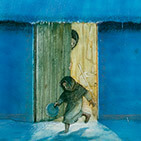Reminiscences of Youth 1968

William Kurelek, Reminiscences of Youth, 1968
Mixed media on hardboard, 125.1 x 149.5 cm
The Thomson Collection, Art Gallery of Ontario, Toronto
Kurelek completed countless paintings of his childhood and early adulthood in Alberta and Manitoba. His memory paintings arguably remain his best-known and most popular body of work. Reminiscences of Youth is unique, however, for its self-reflexivity. In this unconventional self-portrait, Kurelek does not merely offer up a nostalgic scene but paints himself engaged in the act of constructing a reminiscence. The artist appears as he did in his formative years, lying on a bed in what is likely the Winnipeg house he lived in while attending high school and university in the city.

The central image is a representation of a painting on a bedroom wall. The image of children playing on a snow-covered pile of hay contains tableaus of lightheartedness and cruelty and recalls motifs Kurelek began perfecting in the early 1950s in such works as Farm Children’s Games in Western Canada, 1952. The central image occupies an autonomous space, both metaphorically and literally. It “glows like a movie screen” and forms an emanation of memory itself. It stands apart from the surrounding interior scene, which is not part of the central painting but of its extended frame.
During the 1940s, the period represented by the central image, Kurelek’s appreciation for his parents’ culture was expanding. This is highlighted by the presence of the hastily scrawled words to the Ukrainian folk song “There Stands a High Mountain,” written by the nineteenth-century Romantic lyric poet Leonid Hlibov, on the table in the right foreground. The words and music, which we imagine Kurelek listening to through his record player, highlight the painting’s bittersweet tone: “Spring time will return anew / This it is that brings sadness and pain / For youth will never come back / It will not ever return again.”

 About the Author
About the Author
 More Online Art Books
More Online Art Books
 Acknowledgements
Acknowledgements